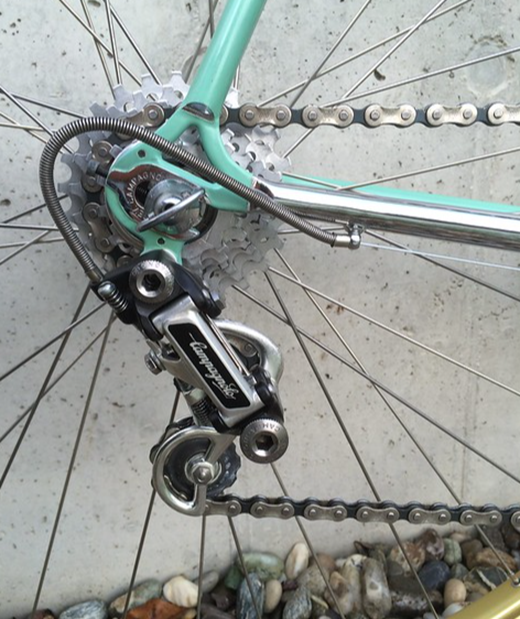SPOTLIGHT BICYCLE OF THE WEEK
Bianchi 1981 Super Corsa
SPECIAL THANKS TO FLICKR AND VINTAGE BIKE ART FOR THE IMAGES CONTAINED IN THIS ARTICLE!

Our selection for this week’s featured bicycle is the exceptional 1981 Bianchi Super Corsa, a remarkable example of Italian cycling excellence that appears to have rolled straight from the showroom floor. This immaculate road racing machine represents the pinnacle of early 1980s bicycle engineering, showcasing premium materials and meticulous craftsmanship. The pristine condition of this particular model, combined with its comprehensive collection of original documentation and accessories, elevates it to collector-grade status. At just 19 pounds complete, this lightweight racing bicycle demonstrates the advanced engineering principles that defined competitive cycling during this transformative period.
Historical Significance of the Bianchi Super Corsa
The Super Corsa model emerged during a revolutionary period in competitive cycling history when manufacturers pushed boundaries in frame construction and component design. This flagship racing bicycle featured advanced Columbus tubing technology, incorporating sophisticated butting techniques that enhanced frame rigidity while maintaining minimal weight. The integration of Campagnolo’s prestigious Super Record group set established this model as the ultimate expression of Italian cycling excellence.
Bianchi Racing Heritage and Professional Use
Professional cycling teams throughout Europe relied on the Super Corsa for its exceptional performance characteristics and proven reliability in competitive environments. The frame’s precise geometry and superior handling qualities made it particularly favored among professional racers who demanded responsive acceleration and stable high-speed descending. Italian craftsmen applied traditional brazing techniques with modern precision, creating frames that delivered both aesthetic beauty and functional excellence.
Cultural Impact on Cycling
The influence of this iconic model extended beyond professional racing circles, inspiring enthusiastic amateur cyclists to pursue the same level of equipment excellence. Cycling publications regularly featured the Super Corsa in technical reviews and buyer’s guides, cementing its reputation as a benchmark for quality road bicycles. The distinctive Celeste green color scheme became synonymous with Italian cycling tradition and continues to evoke nostalgia among vintage bicycle enthusiasts.
Detailed Specifications and Features
This meticulously preserved 58-centimeter frame showcases remarkable attention to detail in both construction and component selection. The integration of titanium hardware throughout the drivetrain and wheelset demonstrates forward-thinking material choices that were considered exotic for the era. Genuine leather handlebar tape remains supple and intact, providing authentic period aesthetics while maintaining functional grip characteristics.
 |
 |
Premium Component Selection
The complete Campagnolo Super Record gruppo represents the apex of mechanical shifting technology from this golden age of cycling. Precision-engineered brake calipers deliver confident stopping power through elegant twin-pivot mechanisms. The friction-based downtube shifters provide tactile feedback that modern electronic systems cannot replicate, allowing experienced riders to finesse gear changes with practiced precision.
Wheelset and Rolling Stock
Original Mavic OR7 tubular wheels combine aerodynamic efficiency with structural integrity, featuring box-section rim profiles that balance weight savings against durability requirements. These hand built wheels demonstrate the craftsmanship standards that defined high-performance cycling equipment before mass production techniques dominated the industry. The included spare wheelset ensures this bicycle can be ridden and maintained without compromising its originality.
Cockpit and Contact Points
The combination of Nitto stem and handlebars reflects the international component selection that characterized premium bicycles of this era. Japanese precision manufacturing complemented Italian frame artistry, creating harmonious integration of form and function. The legendary San Marco Rolls saddle provides period-correct aesthetics while delivering proven comfort for extended rides.
Condition And Provenance
This extraordinary example comes directly from its original owner who treated it as a cherished possession rather than mere transportation. The flawless Bianchi paint finish exhibits no evidence of wear, crashes, or careless storage. Critical stress points including the bottom bracket shell and water bottle mounting bosses show zero signs of corrosion or fatigue.
Documentation and Extras
The owner also has the original sales literature, technical specifications, and maintenance records that enhance both historical value and future serviceability. Additional tubular tires and the complete spare wheelset represent thousands of dollars in period-correct accessories. The original owner’s manual provides authentic reference material for proper maintenance procedures and component specifications.
Investment Potential
Collectors recognize that finding complete, unmolested examples becomes increasingly difficult as vintage bicycles gain popularity among enthusiasts and investors. The combination of single-owner provenance, exceptional condition, and complete documentation positions this particular Bianchi as a blue-chip investment in cycling history.
Why the 1981 Bianchi Super Corsa
Selecting our featured bicycle requires careful evaluation of historical significance, aesthetic appeal, and mechanical integrity. This Super Corsa excels across all criteria, representing both technological achievement and artistic expression from a pivotal moment in cycling evolution. While contemporary models from manufacturers like Colnago, Pinarello, and De Rosa deserve recognition, few match the comprehensive excellence of this particular example.
 |
 |
The enduring appeal of classic Italian road bicycles continues attracting new generations of enthusiasts who appreciate handcrafted quality and timeless design principles. By highlighting this museum-quality Bianchi Super Corsa, we celebrate not just an individual bicycle but an entire era when passionate craftsmen created functional art that continues inspiring cyclists worldwide.
 |
 |
We are an Amazon affiliate and earn from qualified Amazon purchases with no cost to you. This is for ANY product that you purchase through our links.
If you enjoyed learning about this week’s featured bicycle, don’t miss out on some cycling information you can use and enjoy! Visit our website at pacelinebikes.com Plus, check out our YouTube channel, Bicycle Restoration Man, for detailed restoration videos and showcases of our finished projects. Subscribe and join our community of bike enthusiasts!












